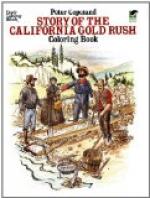Santa Barbara and Ventura are the bean counties of the state, and send Lima beans away by train-loads, while Orange County grows celery for the Eastern market. Very high prices are received for this celery and other vegetables sent from California during the winter season when fields are covered with snow in the East.
And did you know that the state produces a great deal of sugar? Tons and tons of sugar-beets are grown throughout the farming lands, and harvested in September. When the juice of these crushed beets is boiled and refined, it makes a sugar exactly like cane sugar and much cheaper. One-fifth of the beet is sugar, it is said.
Even the dry, worthless mountain sides are valuable to the bee-keeper. The bees make a delicious honey from the wild, white sage, which grows where nothing else will live. This sage honey brings the very highest price.
Oats are raised in the coast counties, and corn in the valleys, but owing to cool nights and dry air the corn seldom makes a good crop. Orange County, however, claims corn with stalks twenty feet high and a hundred bushels to the acre. In the south, also, that wonderful forage-plant, alfalfa, will produce six crops a year by irrigation and give a ton or more to the acre at each cutting.
Along the upper Sacramento River stretch the great hop-fields full of tall vines covered with light-green tassels. At hop-picking season many families have a month’s picnic, children and all working day after day in the fields and pulling off the fragrant hops. Indians, too, are among the best hop-pickers. The dried hops are bleached with sulphur, baled, and in great quantities sent to Liverpool, where with California barley they are used in brewing malt liquors.
An odd crop is mustard, and at Lompoc, in Santa Barbara County, enough for the whole country is grown. Both brown and yellow mustard is cultivated, and the little seeds, almost as fine as gunpowder, are sold to spice-mills and pickle-factories.
Whole farms are taken up with the production of flower-seeds or bulbs, with acres and acres of calla-lilies, roses, carnations, and violets. The tall pampas-grass, with its long feathery plumes, gives a profitable crop. Indeed, one can scarcely name a fruit, flower, or tree that will not thrive and grow to perfection in our mild climate and rich soil.
THE STORY OF THE NAVEL ORANGE
Who has not enjoyed a juicy navel orange, while wondering at its peculiar shape and lack of troublesome seeds? Yet few people know that this particular variety has brought millions of dollars into our state and made orange growing our third greatest industry.
Read this story of the seedless orange, this “golden apple of California,” which was first cultivated by Luther Tibbets, of Riverside, and learn how Southern California has profited by its navel orange crops.




